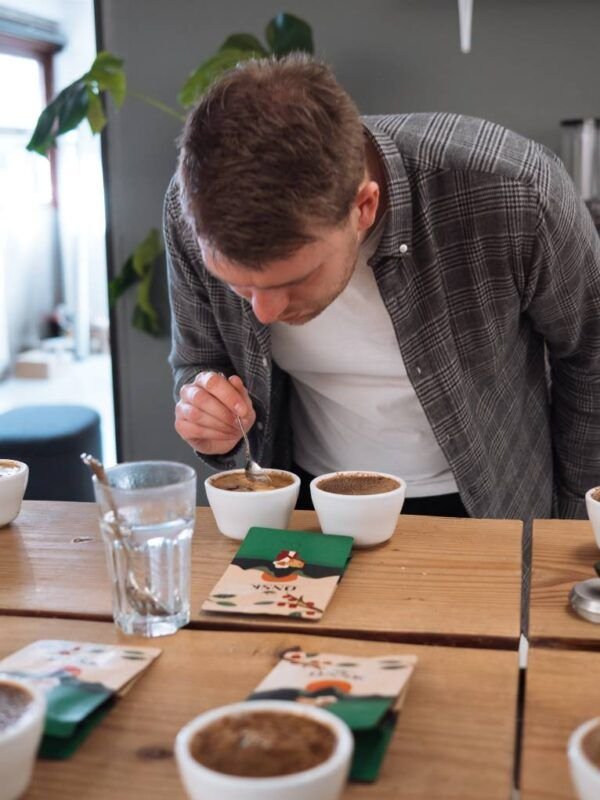A new coffee wave
A new wave of coffee is sweeping over us in the form of specialty coffee. It is called ‘Third-wave coffee’, or coffee’s third wave. Now there must be specialty coffee in the cup, and coffee drinkers around the world are more than willing to pay a nice price for high quality coffee that is produced with good values. But what is specialty coffee and third-wave coffee really about?
Third-wave coffee
“Taste is subjective, but quality shouldn’t be”.
This is how ‘third-wave coffee’ can be briefly explained, according to Trish Rothgeb. The American was the first to classify and name the movements in coffee that we have gone through over time. Right now we are in the third movement, the third wave. The name is inspired by the waves of feminism that have washed over society at regular intervals.
Trish Rothgeb is a coffee expert, trained in Q degrees from Coffee Quality Institute and an expert in assessing whether coffee beans excel to such an extent that they can be given the coveted title of specialty coffee.
According to her, our historical approach to coffee can be divided into three coffee waves:
The first wave (19th century)
Coffee becomes a commodity and consumption grows exponentially. People are starting to see the potential of coffee and are buying it regularly.
The wave is about coffee becoming a staple along with milk and sugar. Something that most households have in the cupboard and a product that has a specific purpose: to get people up and out of bed in the morning with a solid caffeine kick.
Coffee was not a product where consumers demanded neither good taste nor quality. It was all about convenience and low prices. That is why ground coffee in vacuum-packed bags was a hit with coffee drinkers.
Second Wave (1970s)
Starbucks is transforming coffee culture. Coffee becomes something that people meet and gather around to a greater extent, and the coffee shop becomes a meeting place and a huge thing.
The wave is largely about espresso coffee and the coffee varieties you can make based on an espresso shot. The wave also means that consumers are starting to make demands and have expectations for the quality of coffee and the coffee shop.
Third Wave (2000s)
In the third wave, the coffee drinker transforms into a coffee connoisseur. Coffee becomes a product to be enjoyed on par with wine. You start to take an interest in where the coffee comes from, and how it is produced and brewed.
At the same time, the focus is on the coffee value chain. The middlemen, who have so far profited handsomely from keeping the price of green beans down, are now being bypassed by the roasters, who would rather deal directly with the coffee farmers. This gives the roasters more control over the quality, and at the same time, you become an experimenter in coffee production. This means a lighter roast on the coffee beans, which brings out more nuances of flavour in the cup.
There is a whole new awareness about coffee, and people now understand that Nicaraguan coffee tastes different from coffee from Kenya. Single estate and single origin coffee is becoming popular, just as it used to be popular to make pour-over coffee on brewers such as Chemex and Kalita Wave.
It is important to remember that both the first and second waves continue to exist. You can still find vacuum-packed and ground coffee in the supermarket, and for many people, a caffe latte from Starbucks is still one of the highlights of the day. Certainly, not all roasters or producers are interested in where their coffee comes from or how it is produced.

What is specialty coffee?
Not everyone uses the term third-wave coffee. In the coffee industry, the term specialty coffee is used more frequently, but the two terms cover more or less the same thing.
For a coffee to be called specialty coffee, it must score over 80 points The SCA scale. Behind the abbreviation, SCA hides the Specialty Coffee Association, which is a global coffee organization which, in its own words, fights to make specialty coffee a “thriving, fair and sustainable activity for the entire value chain”.
The SCA scale is a way of determining the quality of coffee beans. Through tastings – so-called coffee cupping – the beans are awarded a score of up to 100 points. It is a way of ensuring that the coffee lives up to a standard where it can be described as specialty coffee.
Specialty coffee stands in contrast to commercial coffee – the coffee you find downstairs in the supermarket. But it is certainly not all coffee that is judged. In fact, very few coffee beans go through the official Q-grading, as it is expensive.
Is there a fourth wave coming?
Trish Rothgeb, who is the mother of the term third-wave coffee, believes she can see the contours of a fourth movement within coffee. To an even greater extent, it will be about the people involved in the coffee value chain.
Where the third wave is about paying fair prices to coffee farmers and elevating baristas to recognized artisans, the fourth wave will focus on equality between genders and minorities in the coffee industry.
At VikingRoast we support the Corcasan coffee cooperative, which works with the goal of more female farm owners and employees. So we feel we are already feeling the ripples of coffee’s fourth wave.



Comments are closed.